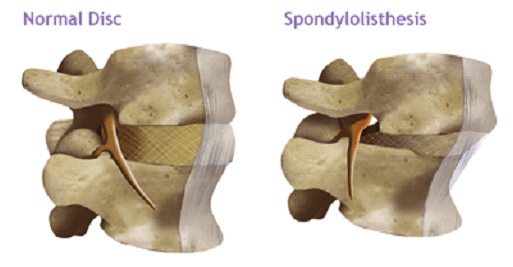Spondylolisthesis is graded according to how much one vertebra slips compared to the adjacent vertebra:
- Grade I – Less than 25 percent
- Grade II – Between 25 and 50 percent
- Grade III – Between 50 and 75 percent
- Grade IV – More than 75 percent
- Grade V – Spondyloptosis occurs when the vertebra has completely fallen off the next vertebra.
Spondylolithesis Causes and Symptoms
Symptoms of Spondylolisthesis
You can have this spinal condition and never actually experience any symptoms; the vertebrae may not move far enough out of place to cause you any pain. However, some patients with spondylolisthesis experience symptoms such as:
- Pain that moves down from your lower back to your legs
- A numb or weak feeling in your legs
- Trouble walking
- Pain in your back or buttock that gets worse when you bend or twist
- A loss of control over your bladder or bowel functions
If you are experiencing a loss of bladder or bowel control, it’s important that you seek treatment from a medical professional right away.
Spondylolisthesis Diagnosis and Treatments in Central New Jersey
Diagnosing Spondylolisthesis
You usually get a spondylolisthesis diagnosis from a spine doctor. In order to start your slipped disc treatment, the doctor will need to take you through a workup to verify that this is the issue that is causing your pain. A workup could include the following:
- Your medical history, including your current symptoms and treatments that you’ve tried in the past.
- A physical examination. The spine doctor will look for symptoms like muscle weakness, loss of sensation, or signs of trauma to the spinal cord.
- Testing including x-rays, CT scans, and MRIs. This gives the spine doctor a clearer view of your spinal column and allows them to diagnose any abnormalities that might be causing your pain. It can also show the doctor how severe your spondylolisthesis is and develop a treatment plan.
Treatment Options for Spondylolisthesis
Non-Operative Treatment
Reducing or stopping any physical activity that might have caused the spondylolisthesis is the first step. This might be a sports-related injury or a repetitive work injury. Your spine doctor might also recommend that you lose weight if he or she suspects excess weight could be contributing to your condition. Other conservative treatment measures include:
- Pain medication including anti-inflammatories, muscle relaxers, and sometimes narcotic painkillers.
- Using hot and cold compresses on the affected areas of your back for a few days.
- Stretching, massaging, and strengthening the back through physical therapy exercises.
- Epidural steroid injections which help your spine doctor locate the spinal nerve that’s causing your pain as well as providing you with temporary pain relief.
Least Invasive Procedures
If you try the conservative treatments listed above for six months and still aren’t getting relief from your symptoms, your spine doctor might recommend surgical intervention. It may also be recommended if your vertebrae continue to slip out of place or if any spinal nerves start to become compressed. If a surgical solution is recommended, an endoscopic foraminoplasty could be the best option.
- Endoscopic Foraminoplasty: If you are experiencing Grade I or II spondylolisthesis, this could be an effective procedure. The goal will be to decrease the pressure in the foramen, an opening around the exiting nerve, while maintaining the stability of the facet joint. That way, the patients shouldn’t require a spinal fusion. A ¼ inch incision is made to gain access to the spinal column, preserving the integrity of the muscles in the back. The spinal surgeon then uses an HD camera to get a view of your spinal cord. You’ll be given conscious sedation and kept comfortable throughout the surgery, lowering the recovery time and risks associated with general anesthesia.
- Endoscopic Rhizotomy: Using a small incision and a microscopic camera, your surgeon will locate the affected nerve and ablate it to help minimize your pain.
- Endoscopic Laminotomy: During this procedure, your surgeon creates a small opening of the lamina right above and below the spinal disc. This relieves nerve compression.
What to Expect After Spondylolisthesis Diagnosis and Treatment?
Spondylolisthesis surgery is generally successful, and it provides much-needed relief from back and neck pain. But certain adjustments will be required shortly after the surgery to promote full recovery, including:
- Help and support from friends and family: Within the first few weeks after surgery, you need people to help you with tasks like house cleaning, yard work and shopping. This support will relieve your body and speed up the healing process.
- Modified workouts: You need to stay active and maintain fitness, but with a different set of activities. Until your doctor certifies you fit for rigorous exercise, you need to avoid high-impact workouts. Instead, you can opt for swimming, yoga and cycling. It’s also important to attend physical therapy sessions to improve your recovery rate.
How Long Does Recovery Take After Spondylolisthesis Treatment?
Recovery time is usually a few weeks. However, if your surgery also included spine fusion, you’ll need to wait for about three to four months. During this time, you need to keep seeing your therapist and specialist for spondylolisthesis pain management before the bones solidify. The success rate for spondylolisthesis is about 90 percent, with patients reporting during follow-up that it relieved them of pain.









